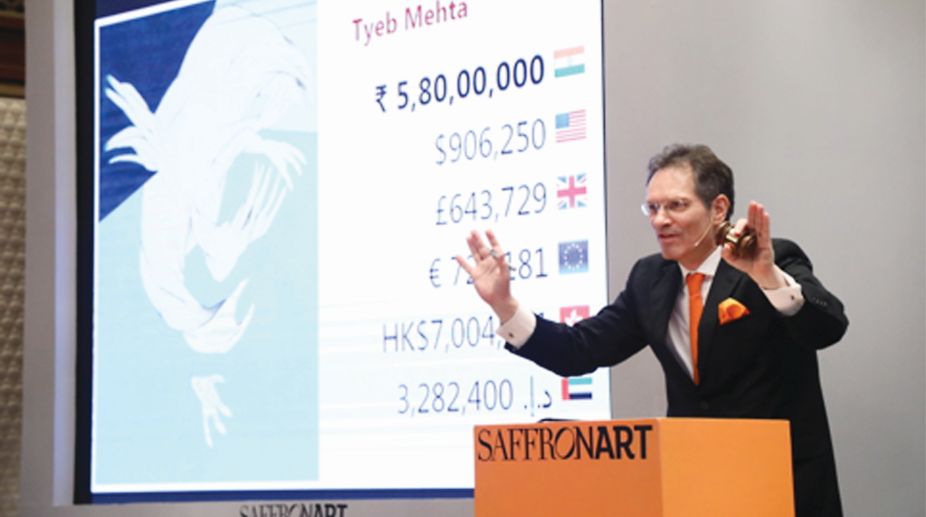PM to inaugurate first Indian Art, Architecture & Design Biennale on Friday
During the programme, Narendra Modi will also inaugurate Aatmanirbhar Bharat Centre for Design at Red Fort and the student Biennale- Samunnati.

Saffronart.
Founded in 2000 by Minal and Dinesh Vazirani, Saffronart is an international auction house, and India’s most reputed, with over a hundred auctions to its credit. It is headquartered in Mumbai, with offices in New Delhi, London and New York.
At the forefront of selling Indian art, Saffronart holds online and live auctions, exhibitions, and prime property sales throughout the year. Their focus is to bring transparency to the auction process, and to provide easy access to bidders around the world.
Advertisement

Saffronart’s services go beyond auctions to include private sales, art storage, appraisals and valuations for their clients, and supporting the efforts of the Indian art world by holding fundraiser auctions. Recently, they have organised an Evening Sale, which achieved Rs 27.6 crore with 80 per cent lots (52 out of 65) being sold.
Advertisement
Tyeb Mehta’s Falling Bird led the auction results at Rs 6.96 crore surpassing its lower estimate of Rs 5 crore. The art was focussed on subjects that referred to the complexities and dilemmas of the human condition.
From his iconic “falling figure” to the trussed bull, Mehta explored a concise repertoire of subjects through an artistic career marked by quiet intensity. Whether the figures were human, animal or bird, they conveyed at times even screamed a sense of disquieting torment and trauma.
These figures in crisis are at once, fantastical and earth-bound — unforgiving goddesses fighting demons to the death, rickshaw-pullers, trussed bulls, and birds and humans hurtling through the void.
The present lot, a human and bird companion in free fall, has its roots in Mehta’s Falling Figure series, which he first began painting in the mid-sixties. This painting is striking for its minimalism and restraint. By creating its own enigmatic narrative, it takes its place alongside some of the most iconic Mehta works that are much sought after by connoisseurs and collectors.
Jehangir Sabavala’s The Star that Beckons, 1968, surpassed its initial estimate of Rs 2.5 to 3.5 crore and sold for Rs 3.84 crore. This is the first of three canvases with the same title, which Jehangir Sabavala painted over the course of three decades. The Star that Beckons II and III were painted in 1999.

The present lot, the earliest exploration of the theme, was painted in 1968, and is arguably the finest, emerging from a time when the young artist was looking for his own voice.
Through the 1960s, Sabavala made a conscious attempt to transcend the principles of Cubism that he had learnt at the Academie Andre Lhote a decade earlier. The Star that Beckons is evocative of the artist’s own journey, guided by his own intuition and the desire for a personal identity.
The painting, with its stark landscape and receding horizon, muted colours and haunting absences, draws from a range of artistic, religious and literary references.
Sabavala’s lone human figure makes a treacherous journey guided by a distant star, and the canvas is weighed down with emotional content that far exceeds the physicality of this minimal, pared down canvas.
S H Raza’s Rajasthan IV, 1961, an important painting from an earlier phase of the artist’s life. Rajasthan IV surpassed its estimate of Rs 1.5 to 2 crore and sold for Rs 2.64 crore. During the 1960s, Raza grew restless in France and began visiting India frequently, rediscovering childhood memories of the forests of Madhya Pradesh.
He also travelled to other parts of India, but it was Rajasthan which inspired some of his most moving works. The colours of his homeland erupted on his canvas in joyous, gestural strokes as seen in the present lot.

Paintings from this period, often named for the places they were inspired by, are non-figural abstractions where the outlines forms have virtually disappeared. But it is the mood which prevails, ‘a certain climate of experience’. It is the brushstroke which assumes importance, to create this mood. Rajasthan becomes a metaphor for the colours of India of vibrant greens and vermilion and ochres, as also blacks.
“The works in Saffronart’s Evening Sale drew attention from bidders around the world. We had strong interest before the sale, with 50 per cent lots receiving advance bids. Works by leading artists from different periods of Indian modernism offered welcome surprises, with works by Sadanand Bakre, A A Raiba, A A Almelkar and K H Ara being well-received.
We look forward to our Classical Indian Art and Folk and Tribal online auctions in April and Summer Online Auction in June, for which we have already consigned some significant masterpieces. We believe these will provide a new level of excitement on our online platform,” said, Hugo Weihe, CEO, Saffronart.
The auction featured works across the spectrum of modern art. A landscape by Sadanand Bakre, initially estimated at Rs 7 to 9 lakh sold for over two times its lower estimate at Rs 16.8 lakh.
Sir Jacob Epstein’s sculpture of Rabindranath Tagore, estimated at Rs 8 to10 lakh doubled its upper estimate, selling for Rs 21.6 lakh. K H Ara’s Yellow Roses, estimated at Rs 7 to 9 lakh doubled its lower estimate and sold for Rs 14.4 lakh.
Advertisement